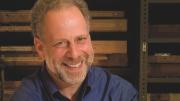Daniel Lieberman didn’t know what to make of the audience member who stood up to ask him a question during a public lecture. The man’s feet were covered in socks and duct tape, instead of shoes.
“He came up to me and said, ‘I don’t like to wear shoes when I run—how come?’” recalled Lieberman, speaking about his research in a recent Q & A with the New York Times.
A runner himself, the professor of human evolutionary biology had been studying human evolution in terms of our early ancestors’ capacity to run, and how running helped them survive. The question asked by Jeffrey Ferris—better known as “Barefoot Jeffrey”—so piqued Lieberman’s interest that he invited the Boston bicycle-shop owner to his lab to demonstrate his running technique. “He ran in this beautiful way that was completely collision-free,” Lieberman told the Times. “Light as a feather. When he hit the ground, he didn’t land on his heel. Instead, he landed on the ball of his foot, and there was no shock wave that hit his head.”
“Obviously, people had run barefoot for millions of years before shoes, socks, Nikes,” Lieberman said in the Times. “I’d sometimes wondered if some of the sports injuries that runners get are related to an issue connected to how people run in shoes—the heel strike, it’s called. When most of us run, we land hard on our heels, and that causes a shockwave and it travels up your leg and eventually hits your head, which jiggles really fast. Those of us who wear shoes think that’s normal, to land with a big jolt.”
Studying Barefoot Jeffrey led Lieberman to publish a paper in Nature that examined differences between barefoot and shod runners related to form, efficiency, impact, and developmental evolution into the bipedal runners humans are today. He and his team found that runners who land on their forefeet land with far less force and far greater efficiency than their heel-striking counterparts, and that even though modern running shoes afford greater cushioning and comfort for a rear-foot strike, this likely does little to lessen the greater impact of a heel strike, or to reduce injuries. They also found that there is no greater skeletal impact when running barefoot on hard surfaces than on soft.
“We evolved to eat different diets, to run differently, and live differently from the ways we do today,” Lieberman said to the Times. “People are looking to evolution to find out how our bodies adapted and what might be healthier for us. That’s good.”
To learn more about Lieberman’s research, read these articles from our archives:







